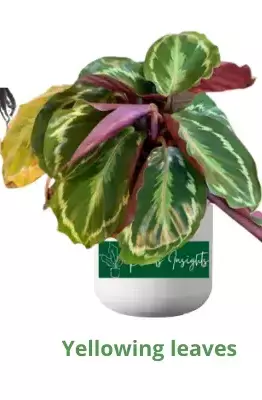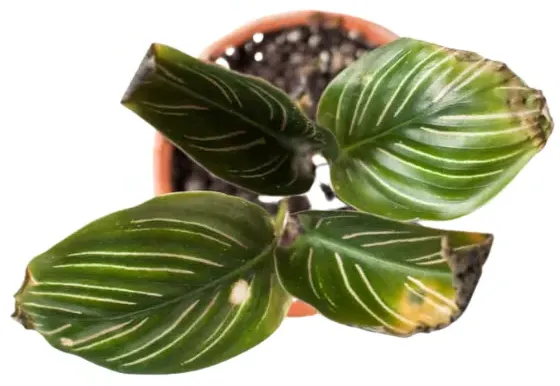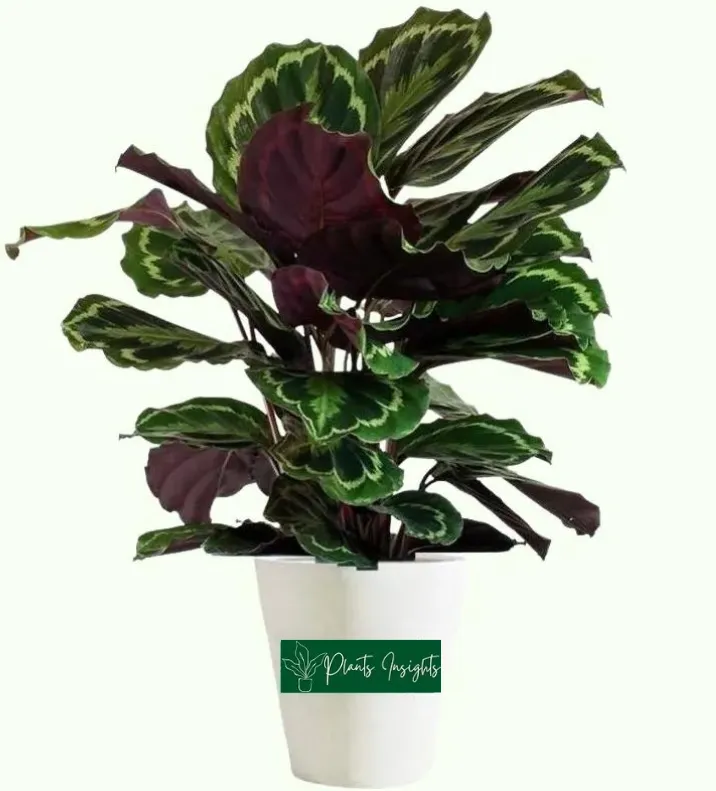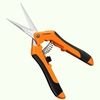Calathea Medallion Roseopicta is a well-admired houseplant that requires little care to be beautiful. The distinctive feature of Calathea Medallion’s charm is its large and oval green leaves. The green foliage of this Calathea has purple undersides. Calathea Medallion will add charm and vigor to any space, whether room or office. Besides brightening up the living spaces, its colorful foliage serves as natural air purifiers. This evergreen plant is perennial, which will illuminate your space all around the year. The tropical plant originates from tropical areas of Colombia.
Calathea Medallion, also known as Medallion Prayer Plant, is an easy-going plant. To make most of your Medallion, provide it with potting soil that is well-draining and water it when necessary. The plant thrives in medium light conditions away from direct sunlight, loves high humidity and ideal temperature range of 65 – 80° F.
Popular Family Members: Calathea White Fusion, Calathea Ornata, Calathea Orbifolia, Calathea Zebrina, Calathea Rufibarba, Calathea Lancifolia, Calathea Louisae
Essential Products
How to Care for Calathea Medallion?
Calathea Roseopicta Medallion plant can grow up as high as 3 feet with breathtaking foliage if proper care is provided. Now let us look into the details of all the requirements to take care of this lovely plant.

Bringing Calathea Veitchiana to Home
When you get your new Calathea Medallion plant, it’s important to check for pests thoroughly. If there are any signs of infestation on the leaves or soil surface, immediately move the plant onto quarantine treatment. It is preferable to keep any new plant in your home away from other plants for at least two weeks.
Please wait for two weeks after bringing the Calathea home before fertilizing. These plants can be fussy in their new surroundings and require some time to adjust to the new environment.

How often should I water my Calathea Medallion?
Watering houseplants is often a mistake that leads to root rot, fungus gnats, and other issues. Like it’s other family members Calathea Zebrina and Louisae, water your Calathea Medallion thoroughly when you first notice that they’re thirsty. This will help prevent root rot and fungus gnats caused by inadequate watering. The best course of action would be to press the soil gently to check for the presence of water. If the soil in the top 1 inch of the layer of soil feels dry on touch, you can proceed with deep watering of the plant.
Calathea Medallion is more sensitive to overwatering than being dry for a short period; therefore, to be on the safe side, you may prefer underwatering the plant rather than overdoing it.
When watering your Calathea Medallion, make sure you follow these few steps:

Calathea Light Requirements
Small plants like Calathea Medallion are protected from direct sunlight exposure by canopies formed by larger trees in their natural habitat. Therefore, Calathea Medallion thrives in medium indirect sunlight. Though they grow well with a little bit of both bright and dull-looking indoor environments, however, prefer brighter surroundings for optimal growth.
The best place you can keep this amazing plant is where there’s plenty of natural sunlight coming through windows or east-facing doors throughout the day. However, please ensure the plant is not exposed to direct sunlight; otherwise, they may suffer leaf burn from direct sun exposure on one side only, which turns them into stripes rather than evenly variegated pieces as nature intended.
The leaves will scorch and turn brown when placed under direct sunlight. If you notice that some of your plants’ leaf tips have died or grown dried out because of being in too much light for an extended period, move them away from these harmful sources until they recover. You can also prune dead leaves off, as it tends Calathea Medallion
to grow more rapidly, which improves its appearance overall.

Temperature and Humidity
Your Calathea Medallion is beautiful, but they need to be cared for in order not only to survive but thrive. The ideal temperature range for the plant is 65°F – 80° F, meaning that the average room temperature shall be suitable for your plant’s needs. Make sure you keep them away from hot sunlight or radiators because this can cause stress on the plants, which may lead their leaves to curl depending upon how severe the exposure is.
Cold weather is not kind to Calatheas, so you should be sure your Calathea Medallion is not exposed to it. The minimum temperature for this plant is 55°F. Therefore, if you are growing Calathea Medallion outside, please make sure to bring it in once the night temperature drops from 60°F.
Whenever you’re growing Calathea Medallion plants, it’s important to maintain high humidity levels. The ideal humidity level for Medallion Prayer Plant is 50-60%. There are many ways of achieving this if you live in a dry area. The best way is by using a room humidifier if your home has one available.
Otherwise, you can group your plants together to retain the moisture or place the pots over a pebble tray containing water. However, ensure that the water level in pebble trays is lower than the pot bottom. In winter, it’s difficult to maintain the perfect humidity level in your home.
Additionally, you may experience low humidity due to heating and cooling systems. But maintaining optimum humidity level is of prime importance for your Calathea Medallion health. Low humidity levels can cause Calathea Medallion leaves to droop and become crisp.

Cleaning and Maintenance
All types of Calathea plants require very little maintenance. Calathea Medallion also does not require extensive pruning. The leaves that become dead or go through color change need to be removed from time to time.
Leaves are large enough to make it easy for you to clean them off with damp cloths. Don’t forget to clean the leaves occasionally to remove pests and eggs from your plant leaves. Dish soap added into water works well as an insecticide for more effective control over pests.

Calathea Medallion Soil Requirements
Grow your Calathea Medallion in a potting mix with good drainage. This Calathea, like other family members Calathea Rufibarba and Ornata, does not favor living in waterlogged soil. It is best to make sure there are adequate holes or grooves throughout the container so that excess moisture can escape while still allowing them enough oxygen to breathe.
An ideal combination of soil for Calathea Medallion would be a mixture of Potting Soil, Orchid Bark, Charcoal, and Perlite. However, if you intend to go for a ready-made soil mix, soils mixtures are available made specifically for Calatheas. If you cannot find one in your nearest garden center, soil mix for African Voilet shall also work.

Fertilizing Calathea Medallion
To keep your Calathea Medallion plant healthy, you must feed them every four weeks during the growing season. This period includes spring until summer ends. Feeding these plants in winter is not required as they go into dormancy for winter. We need to be careful while fertilizing as these plants may suffer from root burn or die if over-fertilized. The best practice is to use a balanced houseplant fertilizer and make it less concentrated up to 1/4 strength.
When growing Calathea Medallion at home, removing excessive minerals built up in soil is necessary by flushing the soil. Plants in pots tend to build up mineral salts, leading them into a weakened state even if you feed your plant correctly.
Follow below simple steps for flushing your Calathea Veitchiana.

Repotting
Plan repotting your Calathea Medallion as it will facilitate refreshing the potting mix, adds more space for roots growth and will help in eliminating problems related to fungus in the soil. However, it should only be repotted once per year.
Repotting is required when plants need an extra boost of nutrient soil or want more volume when roots grow too large compared to pot size. The ideal repotting time for Calathea Veitchiana is in spring; however, it can also be done in summer when the plant is growing.
Follow the simple guide for repotting your Clathea Medallion.

Propagation
You can propagate Calathea Medallion by dividing the roots early in the season of growth. It is done with moderate success when propagating this plant, but only try if you have a well-established and healthy houseplant. It’s difficult and often unsuccessful to propagate Calathea Veitchiana by seeds or cuttings. It is preferable to plan propagation along with repotting.
Take the following measures while repotting the plant for propagation.

Toxicity
With its oval-shaped leaves, Calathea Medallion is a popular houseplant. However, the attraction to these plants can be dangerous for pets and humans alike. Calathea Medallion is nontoxic to cats, dogs, other house pets, and humans.
Even if it’s nontoxic, eating a large number of plant leaves could cause problems with your pet or others nearby, such as children who might play near them at home. There have not been any negative health issues linked with Calathea Medallion; however, it is better to keep an eye on pets and kids if they are in the habit of chewing at plant leaves.

Common Problems and Queries
Pests
Calathea Medallion plants are often host to pesky fungus gnats, which love moist soil. The gnats population can be controlled with yellow sticky traps, and some pesticides work well against these pests.
Another plant-loving pest that loves Calatheas is Spider mites. They generally don’t prefer high humidity, but exceptions can be made because of spider mites’ love for Calathea plants. Try to remove manually as much infestation as possible. However, if the situation gets worse, treat your plants with an insecticide for a month or so to eliminate them.
Thrips also infect Calathea Medallion. Thrips are small insects that are difficult to spot. They have black bodies with white stripes, and their presence may go unnoticed until it is too late. The larvae look like small white grubs while adults appear black.
If left unchecked, these also spread easily between plants, so treat them immediately upon noticing infestation symptoms. Other common pests that can attack Calathea Medallion are Mealybugs and aphids.
Leaves Browning
Calathea leaves turning brown is a sign that thrip infestations may be present. You will notice tiny black insects on the underside of Calatheas’ leaves or stalks, which can cause discoloration in some cases. Infestation should be treated with neem oil to get rid of them before further damage occurs.
Why are my Calathea Medallion leaves are yellowing?
If your Calathea Medallion develops yellow leaves occasionally, it’s not a matter of concern. These are the old leaves that are dying because of age. However, if leaves of your Medallion Prayer Plant are frequently getting yellow, it could be a problem. The most probable reason for leaves getting yellow is overwatering.
Please review your watering schedule, and if your watering schedule is ok, please check the plant closely for pests infestation.

Brown Edges on Leaves
The crispy brown edges on the large Calathea leaves are caused by moisture and humidity issues. If the plant’s soil has completely dried and is not receiving enough water, it can result in brown edges of Calathea Medallion leaves. Lack of humidity and exposure to cold temperatures may also result in brown edges.

Why are my Calathea Medallion leaves curling?
Leaves curling and drooping are common problems related to temperature and humidity. Calathea plant leaves also change their position with day and night changes. Please do not confuse their normal movement with curling and drooping issues.
Calathea Medallion leaves will curl if exposed to high heat, and low humidity will cause leaves to droop. Adjust your plants’ climatic condition, and Calathea Medallion Roseopicta will happily thrive and flourish. You can refer to our article on why Calathea leaves curl and how to fix them?
Why my Calathea Medallion is not flowering?
With its stunning emerald green, silvery and purple leaves, it’s no surprise that Calathea Medallion is a popular houseplant. The plant produces flowers in the wild, but it is rare to bloom indoors. Therefore, if your Calathea Medallion is not booming, there is nothing to worry about and enjoy the beauty of your plant’s colorful foliage.
Is Calathea Medallion easy?
The Calathea Medallion plant is one of the more convenient plants in the Calathea family, and its requirements are much less stringent contrasted to difficult Calatheas like the White Fusion. The plant will reward you with its majestic foliage if provided with moist soil, medium indirect light, high humidity, and warmer temperatures.
Should I mist my Calathea Medallion?
Occasional misting of Calathea Medallion is beneficial for plant’s health as it provides the necessary humidity and moisture that tropical plants crave. However, overdoing it will harm the plant rather than help.
If you over mist the Calathea Medallion, moisture will remain on the leaves for extended periods and can cause leaves fungal diseases. Moreover, the water shall not stay on the leaves overnight; therefore, never mist the plant in the evening.







